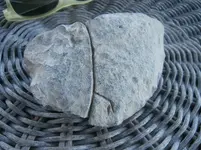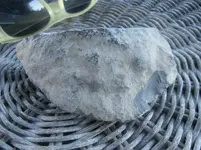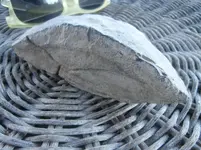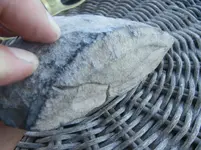You are using an out of date browser. It may not display this or other websites correctly.
You should upgrade or use an alternative browser.
You should upgrade or use an alternative browser.
help figure this out. . . how old? what kind of tool?
- Thread starter Siwash
- Start date
Siwash
Jr. Member
- Joined
- May 31, 2018
- Messages
- 87
- Reaction score
- 85
- Golden Thread
- 0
- Primary Interest:
- All Treasure Hunting
- #4
Thread Owner
The first photo shows a groove made into the rock.
the second photo shows a chipped edge. There is a larger chip, perhaps made during use.
The third and fourth photos show an elliptical groove made into the fat side of the piece.
the second photo shows a chipped edge. There is a larger chip, perhaps made during use.
The third and fourth photos show an elliptical groove made into the fat side of the piece.
Not trying to be funny but, it still looks like a natural rock to me. Good luck and keep hunting because there's plenty more artifacts waiting to be found out there. 
old digger
Gold Member
Agree, It looks natural. I don't see any work do to it by human hands.
arrow86
Silver Member
- Joined
- May 6, 2014
- Messages
- 3,374
- Reaction score
- 4,077
- Golden Thread
- 0
- Location
- Eastern Shore Maryland
- Primary Interest:
- All Treasure Hunting
Can you take some pics of it wet and a profile pic , it may help determine a few things
The Grim Reaper
Gold Member
- Joined
- Apr 3, 2008
- Messages
- 7,805
- Reaction score
- 7,068
- Golden Thread
- 0
- Location
- Southern Ohio
- Primary Interest:
- All Treasure Hunting
I see no evidence of that stone ever being altered or utilized by man.
Saying that, and before you argue with us, I give you this assessment with 53 years of collecting experience which is practically my entire life. Others that responded in kind have as much or more than I so we are not trying to mess with you. We are trying to help. I hope you choose to listen to us. Thank you.
Saying that, and before you argue with us, I give you this assessment with 53 years of collecting experience which is practically my entire life. Others that responded in kind have as much or more than I so we are not trying to mess with you. We are trying to help. I hope you choose to listen to us. Thank you.
- Joined
- Jan 27, 2009
- Messages
- 18,869
- Reaction score
- 12,114
- Golden Thread
- 1
- Location
- South East Tennessee on Ga, Ala line
- 🥇 Banner finds
- 1
- Detector(s) used
- Tesoro Conquistador freq shift
Fisher F75
Garrett AT-Pro
Garet carrot
Neodymium magnets
5' Probe
- Primary Interest:
- All Treasure Hunting
Its limestone. It chips naturally and not used by native Americans unless it was for tempering pottery. Not an artifact. Keep looking.
The Grim Reaper
Gold Member
- Joined
- Apr 3, 2008
- Messages
- 7,805
- Reaction score
- 7,068
- Golden Thread
- 0
- Location
- Southern Ohio
- Primary Interest:
- All Treasure Hunting
I tried.
- Joined
- Mar 2, 2018
- Messages
- 7,200
- Reaction score
- 22,664
- Golden Thread
- 0
- Location
- Todds Point, IL
- Primary Interest:
- Metal Detecting
I tried.
"Welcome my friends to the show that never ends." Gary
newnan man
Gold Member
- Joined
- Aug 8, 2005
- Messages
- 6,738
- Reaction score
- 26,035
- Golden Thread
- 0
- Location
- Beautiful Florida
- Primary Interest:
- Relic Hunting
Tell us this, what would its possible use be? It is not chert either as the flake off the edge proves. It is softer and has cracked by natural forces or machinery. Tools were made for a reason hence the same similar shapes are found far and wide. That is just a rock. Keep looking and you will find a real artifact.
Siwash
Jr. Member
- Joined
- May 31, 2018
- Messages
- 87
- Reaction score
- 85
- Golden Thread
- 0
- Primary Interest:
- All Treasure Hunting
- #15
Thread Owner



If you were to hold this and see the flaked edge of the blade side. . . and recognize that the hand side is carefully cut out. . . and see the rubbing of the ellipse on the hand side and the groove made on the side, you'd recognize the artifact here. Photos don't really help much, unfortunately. This, in my estimation, was a paleo or archaic hand axe or chopper, which was used---and the large chip came out during use, rendering it useless as a tool, thus the owner considered using the rock for smaller tools.
The Grim Reaper
Gold Member
- Joined
- Apr 3, 2008
- Messages
- 7,805
- Reaction score
- 7,068
- Golden Thread
- 0
- Location
- Southern Ohio
- Primary Interest:
- All Treasure Hunting
Sorry, but you are seeing things that just aren't there.
newnan man
Gold Member
- Joined
- Aug 8, 2005
- Messages
- 6,738
- Reaction score
- 26,035
- Golden Thread
- 0
- Location
- Beautiful Florida
- Primary Interest:
- Relic Hunting
Clearly an artifact?



Charl
Silver Member
- Joined
- Jan 19, 2012
- Messages
- 3,076
- Reaction score
- 4,772
- Golden Thread
- 0
- Location
- Rhode Island
- Primary Interest:
- Relic Hunting
Why when we clearly don’t know everything are there so many books and people saying only look for these few things.
There are man made stone artifacts that fall under the heading "problamaticals", meaning they are either clearly man made or they show utilization by humans, but their purpose or function is unknown. Sometimes they are one-offs, so they won't likely appear in artifact guides. Sometimes they are well known classes of artifacts. Plummets would be one such example of such a class, several theories having been offered to explain the function of plummets.
Nobody has ever said one cannot find a one-off artifact that falls into the heading "problematical".
However, what does not prove questionable, what is not subject to debate, is that experience studying both rocks and artifacts brings individuals to the point where recognition does become second nature, and it becomes extremely easy to recognize when a rock is a rock, and an artifact is an artifact. This is a skill set in essence, and it takes time to bring one's skill in distinguishing rock from artifact to that second nature level.
Usually, but not always, people who insist that a rock is an artifact lack the needed experience to have that skill set. As well, they usually don't understand that distinguishing rock from artifact requires time and experience. In a virtual format such as an online artifact forum, the needed experience cannot be transferred to the uneducated beginner. It takes time, and as we see so often here, some people refuse to learn. They refuse to understand these things take time. It's a skill set and it's a learning curve. Simple as that. Folks who have that skill set, born of experience, can render accurate opinions very easily and quickly. Sadly, sometimes you can bring a horse to water, but you just can't force him to drink it.
Similar threads
- Question
- Replies
- 7
- Views
- 439
- Suggestion
- Replies
- 10
- Views
- 976
- Replies
- 23
- Views
- 1K
Users who are viewing this thread
Total: 1 (members: 0, guests: 1)







